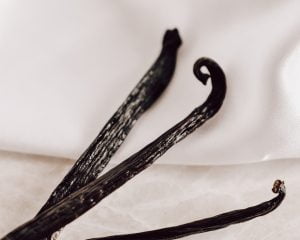
In the realm of healthy living, the allure of natural oils and scents holds a special place. Among these, vanilla plant oil stands out as one of the most beloved and captivating fragrances. Originating from the tropical regions of Mexico, vanilla has been cherished for centuries not only for its sweet and comforting aroma but also for its versatile uses in cosmetics, food, and perfumery.
Origin and Intriguing Plant of Vanilla
The vanilla plant, scientifically known as Vanilla planifolia, belongs to the Orchidaceae family. Native to the humid forests of Mexico, vanilla is a climbing vine that wraps around trees and other support structures to thrive. The plant’s unique characteristic lies in its delicate and enchanting flowers, which are only pollinated naturally by specific species of bees and hummingbirds found in its natural habitat. The vanilla plant’s cultivation outside its native regions requires hand-pollination, making it a labor-intensive process.
The Molecular Structure and Captivating Scent of Vanilla

The mesmerizing scent of vanilla can be attributed to the complex molecular structure of its main aromatic compound, vanillin. Vanillin is a phenolic aldehyde responsible for the warm, sweet, and comforting fragrance that makes vanilla universally beloved. This compound is also found in other plant sources but in smaller quantities compared to the concentrated levels found in vanilla beans.
Vanilla’s Versatility in the Cosmetics and Food Industry
The benefits of vanilla extend far beyond its alluring aroma. In the cosmetics industry, vanilla oil and extracts are popular ingredients for skincare products due to their antioxidant properties. They can help protect the skin from damage caused by free radicals and promote a youthful and radiant complexion. Vanilla’s anti-inflammatory attributes also make it effective in soothing skin irritations and reducing redness.
In the food industry, vanilla is a cornerstone of flavoring. Vanilla extract, derived from the cured beans, is widely used in baking, desserts, beverages, and savory dishes. Notably, pure vanilla extract adds depth and richness to recipes, elevating the taste and aroma of the final product.
Vanilla in Perfumery: Fragrance of Elegance and Timelessness
The captivating scent of vanilla is a cherished note in perfumery, known for adding depth, warmth, and sweetness to fragrances. In perfumes, the vanilla aroma can range from a simple and comforting base note to a complex and sophisticated bouquet when blended with other essential oils.
There are several types of vanilla-based scents used in perfumery:
- Vanilla Absolute: Obtained through solvent extraction, vanilla absolute is a concentrated, thick, and rich extract. It has a deep, sweet aroma and is often used in high-end perfumes.
- Vanilla Essential Oil: Although rare, vanilla essential oil is steam-distilled from the vanilla beans. It has a lighter scent compared to the absolute and is sometimes used as a middle note in perfumes.
- Vanilla Fragrance Oil: A synthetic alternative to natural vanilla extracts, fragrance oils mimic the scent of vanilla and are used in commercial perfumery and scented products.
Embracing the beauty of vanilla not only offers a delightful aromatic experience but also provides a myriad of benefits to enhance both our well-being and the products we cherish daily. So, the next time you encounter the alluring aroma of vanilla, take a moment to appreciate the wonders of this remarkable plant and the aromatic treasure it offers to the world.

